Aakash Repeater Courses
ApplyTake Aakash iACST and get instant scholarship on coaching programs.
Everything around us is made up of something, and that something behind everything is an atom. From the air we breathe and the water we drink to the stars, planets, and galaxies, everything is made up of small compounds, and these compounds are so small that we cannot even see or feel them with the naked eye. To see them, we require a microscope. Atoms are the fundamental building blocks of everything around us, from the gold or diamonds used in jewellery to the silicon used in mobile phones. This chapter consists of various important topics like atoms, subatomic particles, and the theories given by famous scientists like Rutherford, Dalton, and Thomson, who gave Thomson's model of an atom, etc.
The NCERT solutions for Class 9 Science Chapter 4 will offer a systematic and structured approach for the exercise problems in the NCERT textbook to prepare well for your exams by providing comprehensive and detailed solutions to all the exercise questions. Our subject matter expert prepares these solutions, which also serve as a valuable resource for students to enhance their exam performance in board exams.
To get all the solved exercise questions, click below on the download PDF icon. In this PDF, you will get detailed solutions to all the questions that are given in the NCERT textbook.
Topic 4.1 Charged particles in the matter? (Page 39)
Question 1. What are canal rays?
Answer:
Canal rays are the positively charged radiations that consist of positively charged particles of atoms. They can pass through the perforated ( pierced ) cathode and then travel towards another cathode in a gas discharge tube.
They were given the name Canal rays by E. Goldstein in 1866, who discovered these radiations.
Question 2. If an atom contains one electron and one proton, will it carry any charge or not?
Answer:
The proton is a positively charged particle and the electron is a negatively charged particle. their magnitude is equal and hence net charge in an atom is zero.
Topic 4.2 The structure of an atom ( Page 41)
Question 1. On the basis of Thomson’s model of an atom, explain how the atom is neutral as a whole.
Answer:
According to Thomson’s model of an atom, an atom consists of a sphere of a positive charge.
The positive charge in the atom is spread all over like the red edible part of a watermelon, while the electrons are studded in the positively charged sphere, just like the seeds in the watermelon.
As negative and positive charges are equal in magnitude, they balance each other and thus the atom becomes electrically neutral as a whole.
Answer:
On the basis of Rutherford’s model of an atom, the subatomic particle which is present in the nucleus of an atom is Proton which is a positively charged particle.
Question 3. Draw a sketch of Bohr’s model of an atom with three shells.
Answer:
The sketch of Bohr’s model of an atom with three shells:
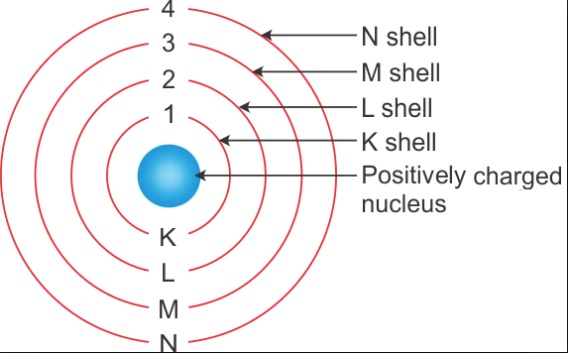
Answer:
If a foil of a heavy metal like platinum is used, then the observations in the alpha-particle scattering experiment would be the same as that in the gold foil experiment.
If a foil of a light metal like lithium is used, then the observations in the alpha-particle scattering experiment would not be the same because these metal are not so malleable so the thin foil is difficult to obtain.
The problem with not using thin foil is that the number of the alpha particle will bounce back from the thick foil and the location of positive mass would be difficult to find.
Topic 2.4.2 Neutron ( Page 41)
Question 1. Name the three sub-atomic particles of an atom.
Answer:
The three sub-atomic particles of an atom are :
1. Electron: a negatively charged particle
2. Proton: a positively charged particle
3. Neutron: a neutral particle
Question 2. Helium atom has an atomic mass of 4 u and two protons in its nucleus. How many neutrons does it have?
Answer:
The atomic mass of Helium = 4 u
No. of protons = 2
As atomic mass = no. of protons + no. of neutrons
No. of neutrons = At. mass - no. of protons
= 4 - 2
= 2
Hence Heium atom has 2 neutrons.
Topic 4.3 How are electrons distributed in different orbits(shells)? ( Page 42)
Question 1. Write the distribution of electrons in carbon and sodium atoms.
Answer:
Number of electrons in a carbon atom = 6
Number of electrons in a sodium atom = 11
Electron Distribution:
| Element | First Orbit or K -K-shell | Second Orbit or L-shell | Third Orbit or M-shell |
| Carbon | 2 | 4 | 0 |
| Sodium | 2 | 8 | 1 |
Question 2. If
Answer:
Maximum Number of electrons in K-shell = 2
Maximum Number of electrons in L-shell = 8
The total no. of electrons in the atom = 2 + 8
= 10
If
Topic 4.4 Valency (Page 44 )
Question 1. How will you find the valency of chlorine, sulphur and magnesium?
Answer:
Valancy is basically the minimum number of the electron we have to add or remove such that every shell in the atom is completely filled.
Mathematically,
when the outermost shell of an atom contains 4 or less than 4 electrons, its valency is equal to the number of valence electrons in the outermost shell and when the outermost shell contains more than 4 electrons, the valency of the atom is equal to 8 - no. of valence electrons in the atom.
Chlorine :
Atomic No. of Cl = 17
Its electronic configuration = 2, 8, 7
Valency of Cl = 8 - 7 = 1
Sulphur :
Atomic no. of S = 16
Its electronic configuration = 2, 8, 6
Valency of S = 8 - 6 = 2
Magnesium:
Atomic no. of Mg = 12
Its electronic configuration = 2, 8, 2
Valency of Mg = 2
Topic 4.5 Atomic number and Mass number ( Page 44)
Question 1.(i) If the number of electrons in an atom is 8 and the number of protons is also 8, then
(i) what is the atomic number of the atom?
Answer:
Given,
Number of electrons in the atom = 8
Number of proton in the atom = 8
The atomic number of an atom is equal to the number of proton in that atom. hence the atomic number of the given atom is 8.
Question 1. (ii) If the number of electrons in an atom is 8 and the number of protons is also 8, then
(ii) what is the charge on the atom?
Answer:
In the given atom, the total number of positive charges is equal to the total number of negative charge.
Number of Protons (8) = Number of electrons (8)
They both will neutralize each other. So, the atom will not possess any charge.
Question 2. With the help of Table 4.1, find out the mass number of oxygen and sulfur atom.
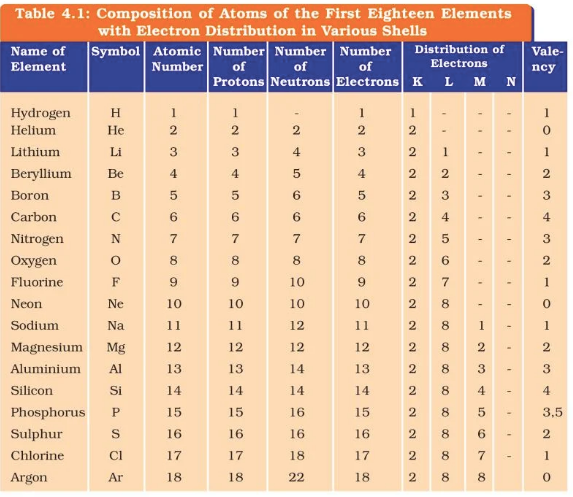
Answer:
For Oxygen:
Number of protons = 8
Number of electrons = 8
Mass number = Number of Protons + Number of neutrons
= 8 + 8
= 16
Hence mass number for Oxygen is 16.
For Sulphur:
Number of protons = 16
Number of electrons = 16
Mass number = Number of Protons + Number of neutrons
= 16 + 16
= 32
Hence Mass number for Sulphur is 32.
Topic 4.6 Isotopes (Page 45)
Question 1. For the symbol
Answer:
H, D, and T are the three isotopes of hydrogen with the same atomic number and different mass numbers of 1, 2 and 3 respectively.
| Element | Symbol | Number of Electrons | Number of Protons | Number of Neutrons |
| Hydrogen | H | 1 | 1 | 0 |
| Deuterium | D | 1 | 1 | 1 |
| Tritium | T | 1 | 1 | 2 |
Question 2. Write the electronic configuration of any one pair of isotopes and isobars.
Answer:
Isotopes :
Isotopes are the atoms with the same number of proton and different atomic mass. The difference in atomic mass arises due to the different number of neutrons present in the atom.
Some Examples of Isotopes are :
1.
2.
Isobar:
Isobars are the atom with the same atomic mass and different atomic number.
Some example of Isobars are :
1.
2.
Question 1. Compare the properties of electrons, protons, and neutrons.
Answer:
The Comparison of Properties between Electron, Proton, and Neutron:
| Properties | Electrons | Protons | Neutrons |
| Charge | Negatively charged | Positively charged | No charge |
| Weight | Negligible | 1 a.m.u | 1 a.m.u |
| Location in atom | Outside the nucleus | Inside the nucleus | Inside the nucleus |
| Reaction with a charged particle | Attracts positive charge | Attracts negative charge | gives no reaction to any charge |
Question 2. What are the limitations of J.J. Thomson’s model of the atom?
Answer:
The limitations of J.J. Thomson’s model of the atom are:
1. Thomson's model of the atom could not explain the results of alpha particle scattering experiment carried out by Rutherford. this model failed to depict why most of the alpha particle passes through gold foil and why some of them got diverted in different angles and some of them rebounded and returned back to their paths.
2. It was solely based on the imagination and did not have any experimental evidence.
Question 3. What are the limitations of Rutherford’s model of the atom?
Answer:
The limitations of Rutherford's model of the atom is that It does not explain the stability of the atom. As we know now, when charged bodies move in a circular motion, they emit radiations.
This means that the electrons revolving around the nucleus (as suggested by Rutherford) would lose energy and come closer and closer to the nucleus, and a stage will come when they would finally merge into the nucleus.
This makes the atom unstable, which is clearly not the case. The electrons do not fall into the nucleus, atoms are very stable and do not collapse on their own.
Question 4. Describe Bohr’s model of the atom.
Answer:
In order to overcome the objections raised against Rutherford's model of the atom, Neils Bohr put forward his model of the atom. According to Bohr's model of the atom,
1. An atom holds the nucleus in the center. the whole mass of the atom is concentrated at the nucleus.
2. The negatively charged particle revolves around the nucleus in definite circular paths known as orbits or which are designated as K, L, M, N, etc. or numbered as n = 1, 2, 3, 4, etc. (outward from the nucleus).
3. While revolving in discrete orbits, the electrons do not radiate energy. But when an electron jumps from one energy level to another, the energy of the atom changes.
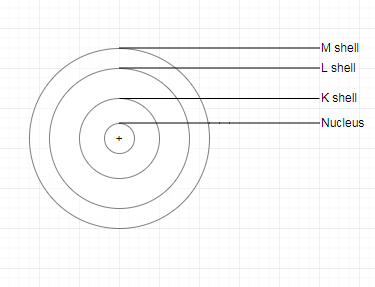
Question 5. Compare all the proposed models of an atom given in this chapter.
Answer:
Comparison of different proposed Model:
| Feature | Thomson's Model | Rutherford's Model | Bohr's Model |
| Positive Charge | The Positive charge is distributed in Sphere | The positive charge is concentrated at the core of the atom, which is called the nucleus | The positive charge is present in the core of the atom, called nucleus. |
| Negative Charge | The electrons are embedded in the positively charged sphere of an atom, like the seeds in a watermelon. | The nucleus is surrounded by electrons, and the electrons and the nucleus are held together by the electrostatic force of attraction | The electrons move in discrete orbits, and each orbit is associated with a definite amount of energy. |
| Limitation | This model could not explain the results of an alpha particle scattering experiment | This model could not explain the stability of the atom. | This model perfectly explains the stability of an atom |
| Diagrammatic representation | 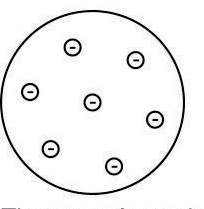 | 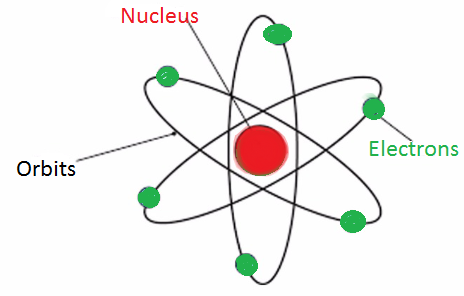 | 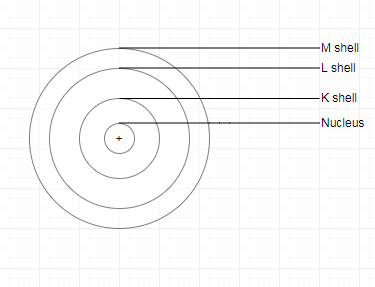 |
Answer:
The Bohr and Bury scheme for the distribution of electrons in an atom is based on the following rules :
1. The maximum number of electrons that a shell can have is represented by
1st (K) shell 2 x
2nd (L) shell 2 x
3rd (M) shell 2 x
4th (N) shell 2 x
2. The outermost shell, which is also called valence shell, can have a maximum of 8 electrons.
3. If permitted by rule 1, The shell inner to the outermost shell (the second last shell ) can accommodate a maximum of 18 electrons.
4. Electrons are not taken in unless the inner shells are filled, i.e., the shells are filled in a step-wise manner.
Question 7. Define valency by taking examples of silicon and oxygen.
Answer:
The definite combining capacity of an atom of an element, in which electrons are lost, gained or shared with other atoms to complete the octave in the outermost shell is defined as valency.
In other words,
Valancy is basically the minimum number of the electron we have to add or remove from or in the outermost shell such that every shell in the atom is completely filled.
And Mathematically,
when the outermost shell of an atom contains 4 or less than 4 electrons, its valency is equal to the number of valence electrons in the outermost shell and when the outermost shell contains more than 4 electrons, the valency of the atom is equal to 8 - no. of valence electrons in the atom.
The valency of Silicon:
Atomic number = 14
Distribution of electron :
K = 2
L = 8
M = 4
Number of electrons in outermost shell = 4
Valency = 8 - 4 = 4.
The valency of Oxygen:
Atomic number = 8
Distribution of electrons:
K = 2
L = 6
The number of electron in outermost shell = 6
Valency = 8 - 6 = 2
Question 8.(i) Explain with examples
(i) Atomic number,
Answer:
Atomic Number :
An atomic number of an atom is the total number of protons present within the nucleus of an atom is known as the atomic number. it is denoted by symbol Z.
Example: As the Oxygen atom has 8 protons in its nucleus, its atomic number is 8.
Question 8.(ii) Explain with examples
(ii) Mass number,
Answer:
Mass Number :
The mass number of an atom is the sum total of the masses of all the nucleons present in the nucleus of an atom, i.e.,
Mass Number = No. of Protons + No. of Neutrons
It is denoted by A.
Example: As a sodium atom has 11 protons and 12 neutrons in its nucleus,
So, it's mass number = 11 + 12 = 23.
Question 8.(iii) Explain with examples
(iii) Isotopes
Answer:
Isotopes:
Isotopes are the atoms of the same element having the same atomic number but a different mass number.
Example: Carbon molecule exists as
Question 8.(iv) Explain with examples
(iv) Isobars.
Answer:
Isobar:
Isobars are the atoms of different elements having the same mass number but different atomic numbers.
Example:
Two uses of isotopes are:
(i) An isotope of uranium is used as fuel in nuclear reactors.
(ii) An isotope of cobalt is used in the treatment of cancer.
Question 9.
Answer:
The atomic number of Na = 11
No. of electrons in Na atom = 11
In
So, No. of electrons in Na + ion = 11 -1 = 10
Hence, electronic configuration of Na + = 2, 8
In Na + , K and L shells are completely filled since K shell can have a maximum of 2 electrons and L shell can have a maximum of 8 electrons.
Answer:
Given, two isotopes
Average atomic mass:
Question 11. The average atomic mass of a sample of an element
Answer:
Given, the average atomic mass of a sample of an element
Two isotopes of element =
Now, Let's percent of isotope
So, According to the question,
Average Atomic Mass :
Hence the percentage of isotope
Question 12. If
Answer:
Given
the Atomic number, Z = 3
Distribution of electrons :
K = 2,
L = 1
So, Valency = 1 .
The element with atomic number 3 is lithium.
Question 13. Composition of the nuclei of two atomic species
X Y
Protons = 6 6
Neutrons = 6 8
Give the mass numbers of
Answer:
As we know,
the mass number of an atom = No. of protons + No. of Neutrons
So,
The mass number of X = No. of protons of X + No. of Neutrons of X
= 6 + 6
= 12
The mass number of Y = No. of protons of Y + No. of Neutrons of Y
= 6 + 8
= 14
As both X and Y have the same atomic number (6) but different numbers (i.e., 12 and 14 respectively), they are isotopes.
Question 14. For the following statements, write T for True and F for False.
(a) J.J. Thomson proposed that the nucleus of an atom contains only nucleons.
(b) A neutron is formed by an electron and a proton combining together. Therefore, it is neutral.
(c) The mass of an electron is about 1 2000 times that of a proton.
(d) An isotope of iodine is used for making tincture iodine, which is used as a medicine.
Put a tick against correct choice and cross (×) against wrong choice in questions 15, 16 and 17
Answer:
(a) The statement is False.
(b) The statement is False.
(c) The statement is True.
(d) The statement is True.
Question 15. Rutherford’s alpha-particle scattering experiment was responsible for the discovery of
(a) Atomic Nucleus
(b) Electron
(c) Proton
(d) Neutron
Answer:
Rutherford’s alpha-particle scattering experiment was responsible for the discovery of the Atomic Nucleus.
Hence, option (a) is the correct answer.
Question 16. Isotopes of an element have
(a) the same physical properties
(b) different chemical properties
(c) different number of neutrons
(d) different atomic numbers
Answer:
Isotopes of an element have a different number of neutrons.
Hence option (c) is correct.
Question 17. A Number of valence electrons in
(a) 16
(b) 8
(c) 17
(d) 18
Answer:
The Electronic configuration of
K = 2
L = 8
M = 8
Hence Number of valance electron in
Hence, option (b) is the correct answer.
Question 18. Which one of the following is a correct electronic configuration of sodium?
(a) 2,8
(b) 8,2,1
(c) 2,1,8
(d) 2,8,1.
Answer:
The atomic number of sodium = 11
The electronic configuration of the sodium :
K = 2
L = 8
M = 1
Hence, option (d) is correct.
Question 19. Complete the following table.
Answer:
| Atomic Number | Mass Number | Number of Neutrons | Number of Protons | Number of Electrons | Number of Atomic Species |
| 9 | - | 10 | - | - | - |
| 16 | 32 | - | - | - | Sulphur |
| - | 24 | - | 12 | - | - |
| - | 2 | - | 1 | - | - |
| - | 1 | 0 | 1 | 0 | - |
First row:
atomic number = 9
so, the element is Fluorine.
Atomic no. = No. of protons = no. of electrons = 9
Mass number = no. of protons + no. of neutrons = 9 + 10 = 19
Second row:
Since atomic no. is 16 so, no. of protons = no. of electrons = 16
No. of neutrons = Mass no. - no. of protons = 32 - 16 = 16
Third row:
No. of protons = Atomic no. = 12
So, the element is Magnesium.
No. of electrons = no. of protons = 12
No. of neutrons = Mass no. - no. of protons = 24 - 12 = 12
Fourth row:
No. of protons = Atomic no. = 1
So, the element is Deuterium.
No. of electrons = no. of protons = 1
No. of neutrons = Mass no. - no. of protons = 2 - 1 = 1
Fifth row:
No. of protons = Atomic no. = 1
The element is Protium since the mass number is 1.
So the Table becomes,
| Atomic number | mass number | Number of neutrons | Number of protons | Number of electrons | Name of the element |
| 9 | 19 | 10 | 9 | 9 | Fluorine |
| 16 | 32 | 16 | 16 | 16 | Sulfur |
| 12 | 24 | 12 | 12 | 12 | Magnesium |
| 1 | 2 | 1 | 1 | 1 | Deuterium |
| 1 | 1 | 1 | 1 | 0 | Hydrogen ion |
The chapter Structure of the Atom will explain to you how the atoms are structured and what subatomic particles they contain. It will feature the discovery of electrons, protons, and neutrons and will also discuss the major atomic models proposed by J.J. Thomson, Rutherford, and Niels Bohr. Students will learn about the limitations of each model and how the modern atomic structure developed. Atomic number, mass number, isotopes (atoms of the same element with different mass numbers), and isobars (atoms of different elements with the same mass number) are covered in this chapter. The concepts are basic yet crucial to understanding how atoms form the basis of all matter.
Question 1: What are the three subatomic particles of an atom?
Answer:
The three subatomic particles are,
Protons (positively charged)
Electrons (negatively charged)
Neutrons (neutral)
Question 2: State two observations from Rutherford’s gold foil experiment.
Answer:
1. Most alpha particles passed straight through the foil, indicating that atoms are mostly empty space.
2. A few alpha particles were deflected or bounced back, suggesting that the positive charge and most of the mass are concentrated in a small, dense nucleus.
Question 3: Define atomic number and mass number.
Answer:
Atomic number (Z)- The number of protons in an atom.
Mass number (A)- The sum of protons and neutrons in an atom.
Mass number = Number of protons + Number of neutrons
Question 4: What are isotopes? Give two examples.
Answer:
Isotopes are atoms of the same element that have the same atomic number but different mass numbers.
Examples,
Hydrogen- Protium (¹H), Deuterium (²H), Tritium (³H)
Carbon- ¹²C and ¹⁴C
Question 5: Calculate the number of protons, electrons, and neutrons in ¹⁷Cl³⁵.
Answer:
Atomic number = 17 → Protons = 17, Electrons = 17
Mass number = 35 → Neutrons = 35 – 17 = 18
To attempt the questions of this chapter effectively, you can practice the following points
1. Understand key concepts- Focus on subatomic particles (proton, neutron, electron), atomic number, mass number, isotopes, and isobars.
2. Study atomic models- Learn the features, experiments, and limitations of Thomson’s, Rutherford’s, and Bohr’s models. You can also use the diagrams to help visualize the structure.
3. Memorize formulas-
Atomic number = Number of protons
Mass number = Number of protons + neutrons
Number of neutrons = Mass number – Atomic number
4. Practice diagrams and numericals- Draw atom models and solve numerical problems that involve atomic/mass number and isotope identification.
5. Write all the definitions on a separate sheet to solve definition-based questions.
6. Solve NCERT examples and practice with in-text questions.
7. Make suitable short notes for quick revision. Timely revise your notes. And practice as many questions as asked in previous board exams and solve mock tests.
All the topics and subtopics covered in the NCERT textbook are listed below:
4.1 Charged Particles in Matter
4.2 The Structure of an Atom
4.2.1 Thomson's Model of an Atom
4.2.2 Rutherford's Model of an Atom
4.2.3 Bohr's Model of an Atom
4.2.4 Neutrons
4.3 How are Electrons Distributed in Different Orbitals(Shells)?
4.4 Valency
4.5 Atomic Number and Mass Number
4.5.1 Atomic number
4.5.2 Mass Number
4.6 Isotopes
4.6.1 Isobars
Some important formulas are given below. You can memorize and use them during practice.
The maximum number of electrons in different shells
According to the Bohr model of the atom, the maximum number of electrons that can occupy a shell is given by the formula 2n2, where n represents the shell number. The first shell (n = 1) can hold a maximum of 2 electrons, the second shell (n = 2) can hold a maximum of 8 electrons, and so on.
Average atomic mass
Average atomic mass = (M1× P1) + (M2 × P2) + ... + (Mn × Pn)
Where:
M1, M2 ..., and Mn represent the individual atomic masses of the isotopes of the element.
P1, P2 ..., and Pn represent their respective natural abundances as decimal fractions or percentages (converted to decimal form).
NCERT chapter-wise solutions are given below:
The NCERT books and syllabus links for class 9 are given below:
Class 9 NCERT subject-wise solutions are given below:
Isotopes are atoms having the same atomic number but different numbers of neutrons. This means they have different mass numbers.
The octet rule states that atoms achieve a full outer shell of eight valence electrons; for that, they tend to gain, lose, or share electrons to resemble the electron configuration of a noble gas (Hydrogen is an exception to the octet rule, aiming for two electrons).
Atom: It is a basic building block of matter. It's the smallest unit of an element that exhibits the chemical properties of that element.
Protons and neutrons are located in the nucleus of the atom. Electrons orbit the nucleus in specific energy levels.

Take Aakash iACST and get instant scholarship on coaching programs.

This ebook serves as a valuable study guide for NEET 2025 exam.

This e-book offers NEET PYQ and serves as an indispensable NEET study material.

As per latest syllabus. Physics formulas, equations, & laws of class 11 & 12th chapters
As per latest syllabus. Chemistry formulas, equations, & laws of class 11 & 12th chapters
As per latest 2024 syllabus. Study 40% syllabus and score upto 100% marks in JEE